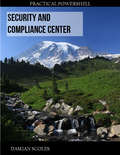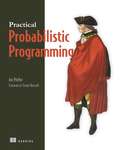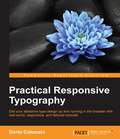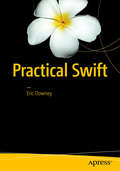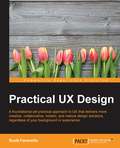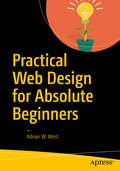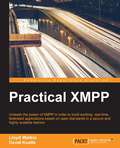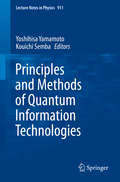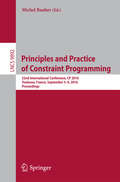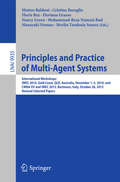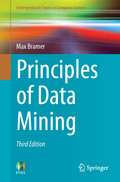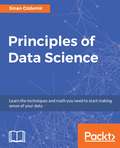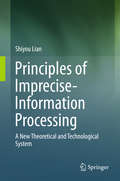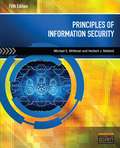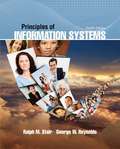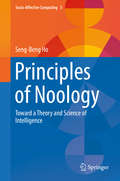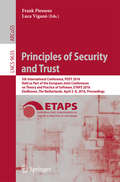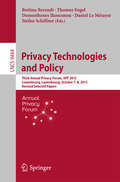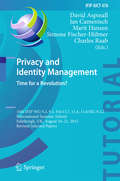- Table View
- List View
Practical PowerShell Security and Compliance Center: Get to grips with effectively managing the Security and Compliance Center with PowerShell, 2nd Edition
by Damian ScolesLearn all the latest practices to build and enhance your PowerShell scripts and manage the Security and Compliance Center easily and efficiently Key Features Gather the latest information and new cmdlets to get started with PowerShell Discover innovative ways to construct useful scripts Learn how to manage SCC with PowerShell through real-world scenarios Book Description PowerShell is an integral part of Office 365. This updated edition shares tips, tricks, new cmdlets, and best practices for using PowerShell with the Security and Compliance Center. The book starts by covering the basic tools of PowerShell, such as PowerShell ISE and PowerShell repositories, and then goes on to teach you how to connect to the SCC using multi-factor authentication. You will manage role groups to layer security, before exploring the importance of information barriers. As you progress, you will orchestrate insider risk policies to protect your organization from malicious users with access to sensitive data. Next, the book will show you how to manage various devices using tenant policies and device access rules. Later chapters will delve into various reporting methods and explore options for troubleshooting scripts and best practices to produce better scripts. The book concludes with an overview of Microsoft Secure Score to help you measure your organization's security posture. By the end of this book, you'll have the latest information and new cmdlets to confidently manage the Security and Compliance Center (SCC) with PowerShell. What you will learn Enhance the script, test it, and move it into production Make your PowerShell scripts more usable and accessible Study directory synchronization and its applications Explore layers of security that prevent unauthorized access Use PowerShell to implement Data Loss Prevention (DLP) Understand compliance and how it can be managed with PowerShell Who this book is for If you are already managing Exchange and have some PowerShell experience, then this book is for you. Professionals who want to gain more proficiency in PowerShell but are unsure of how to approach it will also find this book useful. To get the most out of this book, you must have sufficient experience of working in PowerShell as the book is not a beginner's guide to PowerShell.
Practical Probabilistic Programming
by Avi PfefferSummaryPractical Probabilistic Programming introduces the working programmer to probabilistic programming. In it, you'll learn how to use the PP paradigm to model application domains and then express those probabilistic models in code. Although PP can seem abstract, in this book you'll immediately work on practical examples, like using the Figaro language to build a spam filter and applying Bayesian and Markov networks, to diagnose computer system data problems and recover digital images. Purchase of the print book includes a free eBook in PDF, Kindle, and ePub formats from Manning Publications.About the TechnologyThe data you accumulate about your customers, products, and website users can help you not only to interpret your past, it can also help you predict your future! Probabilistic programming uses code to draw probabilistic inferences from data. By applying specialized algorithms, your programs assign degrees of probability to conclusions. This means you can forecast future events like sales trends, computer system failures, experimental outcomes, and many other critical concerns. About the BookPractical Probabilistic Programming introduces the working programmer to probabilistic programming. In this book, you’ll immediately work on practical examples like building a spam filter, diagnosing computer system data problems, and recovering digital images. You’ll discover probabilistic inference, where algorithms help make extended predictions about issues like social media usage. Along the way, you’ll learn to use functional-style programming for text analysis, object-oriented models to predict social phenomena like the spread of tweets, and open universe models to gauge real-life social media usage. The book also has chapters on how probabilistic models can help in decision making and modeling of dynamic systems. What's InsideIntroduction to probabilistic modelingWriting probabilistic programs in FigaroBuilding Bayesian networksPredicting product lifecyclesDecision-making algorithmsAbout the ReaderThis book assumes no prior exposure to probabilistic programming. Knowledge of Scala is helpful. About the AuthorAvi Pfeffer is the principal developer of the Figaro language for probabilistic programming. Table of ContentsPART 1 INTRODUCING PROBABILISTIC PROGRAMMING AND FIGAROProbabilistic programming in a nutshell A quick Figaro tutorial Creating a probabilistic programming application PART 2 WRITING PROBABILISTIC PROGRAMSProbabilistic models and probabilistic programs Modeling dependencies with Bayesian and Markov networks Using Scala and Figaro collections to build up models Object-oriented probabilistic modeling Modeling dynamic systems PART 3 INFERENCEThe three rules of probabilistic inference Factored inference algorithms Sampling algorithms Solving other inference tasks Dynamic reasoning and parameter learning
Practical Responsive Typography
by Dario CalonaciGet your attractive type design up and running in the browser with real-world, responsive, and tailored tutorials About This Book * No coding experience necessary - get started with responsive typography today! * Find out how to customize your own typography designs to truly own your website's identity * From the basics to cutting-edge design, this book is the perfect guide Who This Book Is For This book is for web developers familiar with the basics of HTML5 and CSS3 who want to learn how to implement responsive typography. No coding experience is required, so dive in and get started! What You Will Learn * Customize and personalize fonts on a responsive website * Learn how to write CSS3 rules for viewports * Define media queries and write them using CSS3 and HTML5 * Implement SASS typography techniques to minimize the CSS output and manage the font variables * Get to grips with dropcaps and learn how to use them effectively on the web In Detail Typography is an essential part of any website's design. It can help you stand out from the crowd, communicate with clarity, and cultivate a distinctive identity. Practical Responsive Typography demonstrates how to use typography to greatest effect. With this book you won't underestimate it's importance - you'll be in complete control over this crucial component of web design. From scaling and optimizing screen spaces to using a range of different web fonts, you'll quickly get up to speed with the practical considerations behind successful typography. But more than the fundamentals, you'll also find out how to go further by customizing typography designs to suit your identity. Style and approach This is an easy-to-follow guide full of real-world examples and tutorials. Each typography style and rule is clearly explained and placed in context.
Practical Swift
by Eric DowneyTake a firsthand tour of Xcode and all the latest features Swift 3 has to offer. If you have picked up this book, chances are you know a little bit about Swift Programming. With Practical Swift you'll develop an advanced understanding of the language that will enable you to create a reference guide using Xcode Playgrounds, one you can continue to grow throughout your iOS career. This book not only shows you how to code in a clean and concise manner, but also the why behind the code. Understanding why will be instrumental in your advancement as a Swift developer. What You'll learn: Review the evolution of Swift and the latest features in Swift 3 Study architecture and design patterns Examine Protocol Oriented Programming Understand Swift generics Test Swift code Build an iOS App with core data from scratch Who This Book Is For: The primary audience for this book is developers who have started learning iOS and Swift and want to learn more of the intermediate to advanced topics available in Swift. The secondary audience is developers who have experience in iOS and Swift and want a good reference book for concepts they might already know, but are looking to re-enforce.
Practical UX Design
by Scott FaranelloA foundational yet practical approach to UX that delivers more creative, collaborative, holistic, and mature design solutions, regardless of your background or experience About This Book * Improve your UX design awareness and skills * Gain greater confidence to know when you have delivered a "good" UX design * Learn by example using a book designed by a UX mind for a UX mind Who This Book Is For This book is written for the beginner as well as the experienced UX practitioner, regardless of team size, company size, or job title. It is also intended for anyone with an interest in UX, engages with UX, is involved in any way in interactive problem solving and design, or simply wants to learn more about what we do, how we do it, and why those in the UX field are so passionate about wanting to do it better. What You Will Learn * Awaken your UX mind and dispel the myths of non-UX thinkers * Create the six optimal conditions for your best ideas to appear * Identify and incorporate the ten design principles found in all good UX design * Develop a broader understanding of Information Architecture (IA) to better engage, guide, and inform * Develop a fundamental understanding of patterns and the properties that create them * Raise your level of UX maturity with a strategy that transforms your approach to problem solving and helps others understand the true value of your work * Utilize important tools of the UX trade that never go out of style * Increase your knowledge of UX, incorporate valuable ideas and insights into your work, and look at design from a very unique perspective In Detail Written in an easy-to-read style, this book provides real-world examples, a historical perspective, and a holistic approach to design that will ground you in the fundamental essentials of interactive design, allow you to make more informed design decisions, and increase your understanding of UX in order to reach the highest levels of UX maturity. As you will see, UX is more than just delighting customers and users. It is also about thinking like a UX practitioner, making time for creativity, recognizing good design when you see it, understanding Information Architecture as more than just organizing and labeling websites, using design patterns to influence user behavior and decision making, approaching UX from a business perspective, transforming your client's and company's fundamental understanding of UX and its true value, and so much more. This book is an invaluable resource of knowledge, perspective, and inspiration for those seeking to become better UX designers, increase their confidence, become more mature design leaders, and deliver solutions that provide measurable value to stakeholders, customers, and users regardless of project type, size, and delivery method. Style and approach An in-depth, easy to read, and entertaining journey into and through the world of UX using real-world examples, thoughtful illustrations, and engaging quotes to inspire and explain fully the how and why of UX in a practical and impactful way and used immediately in your own work.
Practical Web Design for Absolute Beginners
by Adrian W. WestLearn the fundamentals of modern web design, rather than relying on CMS programs, such as WordPress or Joomla!. You will be introduced to the essentials of good design and how to optimize for search engines. You will discover how to register a domain name and migrate a website to a remote host. Because you will have built the web pages yourself, you will know exactly how HTML and CSS work. You have will complete control over your websites and their maintenance. Practical Website Design for Absolute Beginners centers around introducing small amounts of new code in short practical chapters and provides many website templates that can be easily adapted for your own websites. Each chapter builds on the templates created in the previous chapter. You are provided with a practical project to complete in most chapters, and taught to produce practical web pages right from the start. In the first chapter you will install and configure a free text editor, then you will produce the structure for your first web page. You will then gradually learn to create more sophisticated and increasingly practical web pages and websites. In this book you will be encouraged by means of a series of achievable goals, and you will be rewarded by the knowledge that you are learning something valuable and really worthwhile. You will not have to plow through daunting chapters of disembodied code theory because the code is described and explained in context within each project. Because each project is fully illustrated, you will see clearly what you are expected to achieve as you create each web page. What You'll Learn Provides instructions for installing a text editor for producing HTML and CSS Shows you step-by-step how to build and test web pages and websites Teaches you how to ensure that your websites are attractive and useful Describes how to make the most effective use of color and images Teaches you the essential features of search engine optimization Shows you how to migrate your website to a remote host Who This Book Is For Practical Website Design for Absolute Beginners is for people who want to begin designing their own websites. It uses a highly motivational, easily assimilated step-by-step approach where you will start learning practical skills from the very first chapter. The book is an excellent choice for people who have computer skills but would also like to learn HTML and CSS. For readers who have little or no knowledge of HTML and CSS, the book will teach enough to complete all the projects in the book.
Practical Windows Forensics
by Ayman Shaaban Konstantin SapronovLeverage the power of digital forensics for Windows systems About This Book * Build your own lab environment to analyze forensic data and practice techniques. * This book offers meticulous coverage with an example-driven approach and helps you build the key skills of performing forensics on Windows-based systems using digital artifacts. * It uses specific open source and Linux-based tools so you can become proficient at analyzing forensic data and upgrade your existing knowledge. Who This Book Is For This book targets forensic analysts and professionals who would like to develop skills in digital forensic analysis for the Windows platform. You will acquire proficiency, knowledge, and core skills to undertake forensic analysis of digital data. Prior experience of information security and forensic analysis would be helpful. You will gain knowledge and an understanding of performing forensic analysis with tools especially built for the Windows platform. What You Will Learn * Perform live analysis on victim or suspect Windows systems locally or remotely * Understand the different natures and acquisition techniques of volatile and non-volatile data. * Create a timeline of all the system actions to restore the history of an incident. * Recover and analyze data from FAT and NTFS file systems. * Make use of various tools to perform registry analysis. * Track a system user's browser and e-mail activities to prove or refute some hypotheses. * Get to know how to dump and analyze computer memory. In Detail Over the last few years, the wave of the cybercrime has risen rapidly. We have witnessed many major attacks on the governmental, military, financial, and media sectors. Tracking all these attacks and crimes requires a deep understanding of operating system operations, how to extract evident data from digital evidence, and the best usage of the digital forensic tools and techniques. Regardless of your level of experience in the field of information security in general, this book will fully introduce you to digital forensics. It will provide you with the knowledge needed to assemble different types of evidence effectively, and walk you through the various stages of the analysis process. We start by discussing the principles of the digital forensics process and move on to show you the approaches that are used to conduct analysis. We will then study various tools to perform live analysis, and go through different techniques to analyze volatile and non-volatile data. Style and approach This is a step-by-step guide that delivers knowledge about different Windows artifacts. Each topic is explained sequentially, including artifact analysis using different tools and techniques. These techniques make use of the evidence extracted from infected machines, and are accompanied by real-life examples.
Practical XMPP
by Lloyd Watkin David KoelleUnleash the power of XMPP in order to build exciting, real-time, federated applications based on open standards in a secure and highly scalable fashion About This Book * Learn about the fundamentals of XMPP and be able to work with the core functionality both server-side and in the browser * Build a simple 1-to-1 chat (the "Hello World" of XMPP), explore multi-user chat, publish subscribe systems, and work with a decentralized social network * Author Lloyd Watkins is a member of the XMPP standards committee Who This Book Is For If you want to learn about the fundamentals of XMPP, be able to work with the core functionality both server-side and in the browser then this book is for you.No knowledge of XMPP is required, or of TCP/IP networking. It's important that you already know how to build applications of some form, and are looking get a better understanding of how to implement XMPP for one or more of its many uses. You should be interested in the decentralized web, know HTML, and likely know JavaScript and NodeJS. You will probably know JSON, and hopefully XML (this is the native output of XMPP). What You Will Learn * Install and configure an XMPP server and use it to connect from a traditional desktop client and send a message * Build a simple server-side application that will respond to messages from our logged in desktop client * Install and run XMPP-FTW, connect to the server from the browser, and handle incoming/outgoing messages * Connect to a multi-user chat room, send/receive stanzas, add a room password, join a protected room, set the room's subject, and change a user's affiliation * Get to grips with the publish-subscribe extension of XMPP and use it to build a pusher system that can make any website real-time * Build a simple XMPP component and create an extension for XMPP-FTW that allows you to use your own custom format * Build an XMPP version of the classic game "Pong" In Detail XMPP (eXtensible Messaging and Presence Protocol) is a messaging protocol that enables communication between two or more devices via the Internet. With this book, developers will learn about the fundamentals of XMPP, be able to work with the core functionality both server-side and in the browser, as well as starting to explore several of the protocol extensions. You will not only have a solid grasp of XMPP and how it works, but will also be able to use the protocol to build real-world applications that utilize the power of XMPP. By the end of this book, you will know more about networking applications in general, and have a good understanding of how to extend XMPP, as well as using it in sample applications. Style and approach Through a number of hands-on projects, this book shows you how to build usable applications that highlights a feature of XMPP.
Principles Of Digital Communication: A Top-Down Approach
by Bixio RimoldiThis comprehensive and accessible text teaches the fundamentals of digital communication via a top-down-reversed approach, specifically formulated for a one-semester course. The unique approach focuses on the transmission problem and develops knowledge of receivers before transmitters. In doing so it cuts straight to the heart of the digital communication problem, enabling students to learn quickly, intuitively, and with minimal background knowledge. Beginning with the decision problem faced by a decoder and going on to cover receiver designs for different channels, hardware constraints, design trade-offs, convolutional coding, Viterbi decoding, and passband communication, detail is given on system-level design as well as practical applications in engineering. All of this is supported by numerous worked examples, homework problems, and MATLAB simulation exercises to aid self-study, providing a solid basis for students to specialize in the field of digital communication and making it suitable for both traditional and flipped classroom teaching.
Principles and Methods of Quantum Information Technologies
by Yoshihisa Yamamoto Kouichi SembaThis book presents the research and development-related results of the "FIRST" Quantum Information Processing Project, which was conducted from 2010 to 2014 with the support of the Council for Science, Technology and Innovation of the Cabinet Office of the Government of Japan. The project supported 33 research groups and explored five areas: quantum communication, quantum metrology and sensing, coherent computing, quantum simulation, and quantum computing. The book is divided into seven main sections. Parts I through V, which consist of twenty chapters, focus on the system and architectural aspects of quantum information technologies, while Parts VI and VII, which consist of eight chapters, discuss the superconducting quantum circuit, semiconductor spin and molecular spin technologies. Readers will be introduced to new quantum computing schemes such as quantum annealing machines and coherent Ising machines, which have now arisen as alternatives to standard quantum computers and are designed to successfully address NP-hard/NP-complete combinatorial optimization problems, which are ubiquitous and relevant in our modern life. The book offers a balanced mix of theory-based and experimentation-based chapters written by leading researchers. Extensive information is provided on Quantum simulation, which focuses on the implementation of various many-body Hamiltonians in a well-controlled physical system, Quantum key distribution, Quantum repeaters and quantum teleportation, which are indispensable technologies for building quantum networks with various advanced applications and require far more sophisticated experimental techniques to implement.
Principles and Practice of Constraint Programming
by Michel RueherThis book constitutes the refereed conference proceedings of the 22nd International Conference on Principles and Practice of Constraint Programming, CP 2016, held in Toulouse, France, in September 2016. The 63 revised regular papers presented together with 4 short papers and the abstracts of 4 invited talks were carefully reviewed and selected from 157 submissions. The scope of CP 2016 includes all aspects of computing with constraints, including theory, algorithms, environments, languages, models, systems, and applications such as decision making, resource allocation, scheduling, configuration, and planning. The papers are grouped into the following tracks: technical track; application track; computational sustainability track; CP and biology track; music track; preference, social choice, and optimization track; testing and verification track; and journal-first and sister conferences track.
Principles and Practice of Multi-Agent Systems
by Matteo Baldoni Cristina Baroglio Floris Bex Floriana Grasso Nancy Green Mohammad-Reza Namazi-Rad Masayuki Numao Merlin Teodosia SuarezThis book constitutes the thoroughly refereed post-workshop proceedings of the 5th International Workshop on Empathic Computing, IWEC 2014, co-loacted with PRICAI 2014, held in Gold Coast, QLD, Australia, in December 2014, as well as the 6th International Workshop on Empathic Computing, IWEC 2015, and the 15th Workshop on Computational Models of Natural Argument, CMNA XV, both co-located with PRIMA 2015, held in Bertinoro, Italy, in October 2015. The 12 papers presented were carefully reviewed and selected from 32 initial submissions. The workshops are going alongside with the PRIMA 2015 Conference and are intended to facilitate active exchange, interaction and comparison of approaches, methods and various ideas in specific areas related to intelligent agent systems and multiagent systems.
Principles of Data Mining
by Max BramerThis book explains and explores the principal techniques of Data Mining, the automatic extraction of implicit and potentially useful information from data, which is increasingly used in commercial, scientific and other application areas. It focuses on classification, association rule mining and clustering. Each topic is clearly explained, with a focus on algorithms not mathematical formalism, and is illustrated by detailed worked examples. The book is written for readers without a strong background in mathematics or statistics and any formulae used are explained in detail. It can be used as a textbook to support courses at undergraduate or postgraduate levels in a wide range of subjects including Computer Science, Business Studies, Marketing, Artificial Intelligence, Bioinformatics and Forensic Science. As an aid to self study, this book aims to help general readers develop the necessary understanding of what is inside the 'black box' so they can use commercial data mining packages discriminatingly, as well as enabling advanced readers or academic researchers to understand or contribute to future technical advances in the field. Each chapter has practical exercises to enable readers to check their progress. A full glossary of technical terms used is included. This expanded third edition includes detailed descriptions of algorithms for classifying streaming data, both stationary data, where the underlying model is fixed, and data that is time-dependent, where the underlying model changes from time to time - a phenomenon known as concept drift.
Principles of Data Science
by Sinan OzdemirLearn the techniques and math you need to start making sense of your data About This Book • Enhance your knowledge of coding with data science theory for practical insight into data science and analysis • More than just a math class, learn how to perform real-world data science tasks with R and Python • Create actionable insights and transform raw data into tangible value Who This Book Is For You should be fairly well acquainted with basic algebra and should feel comfortable reading snippets of R/Python as well as pseudo code. You should have the urge to learn and apply the techniques put forth in this book on either your own data sets or those provided to you. If you have the basic math skills but want to apply them in data science or you have good programming skills but lack math, then this book is for you. What You Will Learn • Get to know the five most important steps of data science • Use your data intelligently and learn how to handle it with care • Bridge the gap between mathematics and programming • Learn about probability, calculus, and how to use statistical models to control and clean your data and drive actionable results • Build and evaluate baseline machine learning models • Explore the most effective metrics to determine the success of your machine learning models • Create data visualizations that communicate actionable insights • Read and apply machine learning concepts to your problems and make actual predictions In Detail Need to turn your skills at programming into effective data science skills? Principles of Data Science is created to help you join the dots between mathematics, programming, and business analysis. With this book, you'll feel confident about asking—and answering—complex and sophisticated questions of your data to move from abstract and raw statistics to actionable ideas. With a unique approach that bridges the gap between mathematics and computer science, this books takes you through the entire data science pipeline. Beginning with cleaning and preparing data, and effective data mining strategies and techniques, you'll move on to build a comprehensive picture of how every piece of the data science puzzle fits together. Learn the fundamentals of computational mathematics and statistics, as well as some pseudocode being used today by data scientists and analysts. You'll get to grips with machine learning, discover the statistical models that help you take control and navigate even the densest datasets, and find out how to create powerful visualizations that communicate what your data means. Style and approach This is an easy-to-understand and accessible tutorial. It is a step-by-step guide with use cases, examples, and illustrations to get you well-versed with the concepts of data science. Along with explaining the fundamentals, the book will also introduce you to slightly advanced concepts later on and will help you implement these techniques in the real world.
Principles of Imprecise-Information Processing
by Shiyou LianThe book showcases cutting-edge concepts and methods, and presents the principle of imprecise-information processing. It also proposes a new theory and technology for imprecise-information processing that differs from fuzzy technology, thus providing a platform for related applications and laying the theoretical basis for further research. Imprecise-information processing - a type of processing based on flexible linguistic values and quantifiable rigid linguistic values - is an important component of intelligence science and technology. This book offers an easy-to-understand overview of the basic principles and methods of imprecise-information processing, allowing readers to develop related applications or pursue further research.
Principles of Information Security
by Michael E. Whitman Herbert J. MattordSpecifically oriented to the needs of information systems students, PRINCIPLES OF INFORMATION SECURITY, 5e delivers the latest technology and developments from the field. Taking a managerial approach, this bestseller teaches all the aspects of information security-not just the technical control perspective. It provides a broad review of the entire field of information security, background on many related elements, and enough detail to facilitate understanding of the topic. It covers the terminology of the field, the history of the discipline, and an overview of how to manage an information security program. Current and relevant, the fifth edition includes the latest practices, fresh examples, updated material on technical security controls, emerging legislative issues, new coverage of digital forensics, and hands-on application of ethical issues in IS security. It is the ultimate resource for future business decision-makers.
Principles of Information Systems (Twelfth Edition)
by Ralph Stair George ReynoldsEquipping you with a solid understanding of the core principles of IS and how it is practiced, PRINCIPLES OF INFORMATION SYSTEMS, 12E covers the latest research and developments from the field and their impact on the rapidly changing role of today's IS professional. The book includes expansive coverage of mobile solutions, energy and environmental concerns, cloud computing, IS careers, virtual communities, global IS work solutions, and social networking. You learn firsthand how information systems can increase profits and reduce costs as you explore new information on e-commerce and enterprise systems, artificial intelligence, virtual reality, green computing, and other issues reshaping the industry. The book also introduces the challenges and risks of computer crimes, hacking, and cyberterrorism. A long-running example illustrates how technology was used in the design, development, and production of this book. No matter where your career path may lead, PRINCIPLES OF INFORMATION SYSTEMS, 12E can help you maximize your success as an employee, a decision maker, and a business leader.
Principles of Noology
by Seng-Beng HoThe idea of this book is to establish a new scientific discipline, "noology," under which a set of fundamental principles are proposed for the characterization of both naturally occurring and artificial intelligent systems. The methodology adopted in Principles of Noology for the characterization of intelligent systems, or "noological systems," is a computational one, much like that of AI. Many AI devices such as predicate logic representations, search mechanisms, heuristics, and computational learning mechanisms are employed but they are recast in a totally new framework for the characterization of noological systems. The computational approach in this book provides a quantitative and high resolution understanding of noological processes, and at the same time the principles and methodologies formulated are directly implementable in AI systems. In contrast to traditional AI that ignores motivational and affective processes, under the paradigm of noology, motivational and affective processes are central to the functioning of noological systems and their roles in noological processes are elucidated in detailed computational terms. In addition, a number of novel representational and learning mechanisms are proposed, and ample examples and computer simulations are provided to show their applications. These include rapid effective causal learning (a novel learning mechanism that allows an AI/noological system to learn causality with a small number of training instances), learning of scripts that enables knowledge chunking and rapid problem solving, and learning of heuristics that further accelerates problem solving. Semantic grounding allows an AI/noological system to "truly understand" the meaning of the knowledge it encodes. This issue is extensively explored. This is a highly informative book providing novel and deep insights into intelligent systems which is particularly relevant to both researchers and students of AI and the cognitive sciences.
Principles of Security and Trust
by Frank Piessens Luca ViganòThis book constitutes the proceedings of the 5th International Conference on Principles of Security and Trust, POST 2016, which took place in Eindhoven, The Netherlands, in April 2016, held as Part of the European Joint Conferences on Theory and Practice of Software, ETAPS 2016. The 12 full papers presented in this volume were carefully reviewed and selected from 35 submissions. They were organized in topical sections named: information flow; models and applications; protocols.
Principles of Synthetic Aperture Radar Imaging: A System Simulation Approach (Signal and Image Processing of Earth Observations)
by Kun-Shan ChenPrinciples of Synthetic Aperture Radar Imaging: A System Simulation Approach demonstrates the use of image simulation for SAR. It covers the various applications of SAR (including feature extraction, target classification, and change detection), provides a complete understanding of SAR principles, and illustrates the complete chain of a SAR operati
Printreading for Residential Construction, Sixth Edition
by Thomas E. Proctor Leonard P. ToenjesPrintreading for Residential Constructionpresents printreading fundamentals and provides printreading activities related to residential construction. Topics presented include sketching, computer-aided design (CAD), trade math symbols and abbreviations, plot plans, floor plans, elevations, sections, and details. This new edition provides information on revised building codes, LEED for Homes, green building practices, advanced house framing techniques, insulation, and the whole-house systems approach. Content Overview Construction Documents Working Drawing Concepts Trade Math Symbols and Abbreviations Plot Plans Floor Plans Elevations Sections Details Trade Information - Foundations, Framing, and Finishes Trade Information - Electrical, Plumbing, and HVAC Final Review and Exams Appendix Glossary Index
Privacy Technologies and Policy
by Bettina Berendt Thomas Engel Demosthenes Ikonomou Daniel Le Métayer Stefan SchiffnerThis book constitutes the thoroughly refereedpost-conference proceedings of the Third Annual Privacy Forum, APF 2015, heldin Luxembourg, Luxembourg, in October 2015. The 11 revised full papers presented in this volume werecarefully reviewed and selected from 24 submissions. The topics focus onprivacy by design (PbD), i. e. the attempt to combine technical and organizationalmeasures to ensure the basic rights of the individual. The papers are organizedin three sessions: measuring privacy; rules and principles; legal and economicperspectives on privacy.
Privacy and Capitalism in the Age of Social Media (Routledge Research in Information Technology and Society #18)
by Sebastian SevignaniThis book explores commodification processes of personal data and provides a critical framing of the ongoing debate of privacy in the Internet age, using the example of social media and referring to interviews with users. It advocates and expands upon two main theses: First, people’s privacy is structurally invaded in contemporary informational capitalism. Second, the best response to this problem is not accomplished by invoking the privacy framework as it stands, because it is itself part of the problematic nexus that it struggles against. Informational capitalism poses weighty problems for making the Internet a truly social medium, and aspiring to sustainable privacy simultaneously means to struggle against alienation and exploitation. In the last instance, this means opposing the capitalist form of association – online and offline.
Privacy and Identity Management. Time for a Revolution?
by Jan Camenisch Simone Fischer-Hübner Marit Hansen David Aspinall Charles RaabThis book contains a range of keynote papers and submitted papers presented at the 10th IFIP WG 9. 2, 9. 5, 9. 6/11. 7, 11. 4, 11. 6/SIG 9. 2. 2 International Summer School, held in Edinburgh, UK, in August 2015. The 14 revised full papers included in this volume were carefully selected from a total of 43 submissions and were subject to a two-step review process. In addition, the volume contains 4 invited keynote papers. The papers cover a wide range of topics: cloud computing, privacy-enhancing technologies, accountability, measuring privacy and understanding risks, the future of privacy and data protection regulation, the US privacy perspective, privacy and security, the PRISMS Decision System, engineering privacy, cryptography, surveillance, identity management, the European General Data Protection Regulation framework, communicating privacy issues to the general population, smart technologies, technology users' privacy preferences, sensitive applications, collaboration between humans and machines, and privacy and ethics.
Privacy and Power
by Miller Russell A.Edward Snowden's leaks exposed fundamental differences in the ways Americans and Europeans approach the issues of privacy and intelligence gathering. Featuring commentary from leading commentators, scholars and practitioners from both sides of the Atlantic, the book documents and explains these differences, summarized in these terms: Europeans should 'grow up' and Americans should 'obey the law'. The book starts with a collection of chapters acknowledging that Snowden's revelations require us to rethink prevailing theories concerning privacy and intelligence gathering, explaining the differences and uncertainty regarding those aspects. An impressive range of experts reflect on the law and policy of the NSA-Affair, documenting its fundamentally transnational dimension, which is the real location of the transatlantic dialogue on privacy and intelligence gathering. The conclusive chapters explain the dramatic transatlantic differences that emerged from the NSA-Affair with a collection of comparative cultural commentary.
